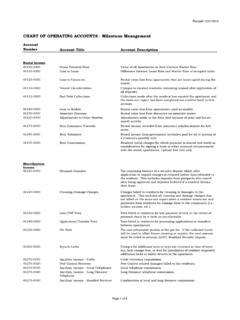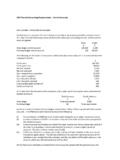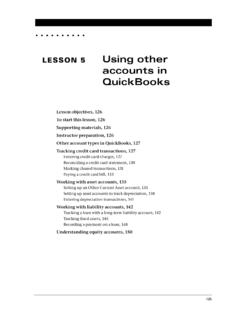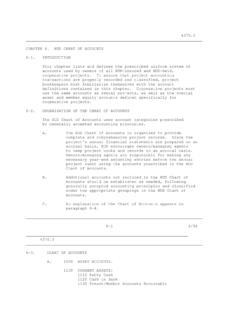Transcription of Missouri 529 Accounts What You Need to Know Overview
1 Missouri 529 Accounts What You Need to Know Overview Parents in Missouri can now get a state tax deduction for private school tuition as a result of the federal tax overhaul passed last month. Families can now use state-sponsored 529 college savings plans to pay for expenses such as tuition, books and tutoring for kindergarten through high school. Missouri families can automatically use 529 monies for K-12 expenses. Illinois families however, will have to wait for the state law to be changed. Missouri residents can deduct from their state taxes up to $8,000 per year for contributions to 529 plans. Illinois residents could deduct up to $10,000 per child each year if state law is changed to allow it. According to the Missouri Treasurer s office, there are more than 154,500 active 529 plans in Missouri with a collected value of about $3 billion in assets.
2 Nationally, 75% of 529 plan owners were in middle class families with household incomes of $150,000 or less. Seventeen percent had incomes of $50,000 or less. Coverdell vs. 529 plans Coverdell Education Savings Accounts , approved in 2001 and still an operation under the tax code, allow families to earn tax-exempt interest on up to $2,000 in annual savings for specified expenses, including tuition, associated with elementary, secondary or post-secondary education in public or private schools. The $2,000 cap on annual investments and an income limit on eligible investors are two of several differences between Coverdell Accounts and 529 s. How 529 s Work 529 s allow for the tax-free growth of investment funds that are used for qualified expenses.
3 The plans invest funds over time under the name of the owner of the account for the benefit of the beneficiary named on the account . Any interest or investment income earned on the funds are tax-free, provided they are used for the qualified expenses as designated by the tax code. Terms of the plans can vary by state. The definition of qualified expenses was expanded on January 1, 2018 to allow those funds to also be used for tuition in independent and private schools. The new language provides that higher education expenses can now include up to $10,000 per student to be used for independent school tuition. For families with very young children, this benefit is potentially substantial as families can put much of their long-term educational investments in one place to grow tax-free.
4 Some form of state income tax deduction is allowed when a deposit is made to a 529 account . In Missouri , this means that a family with two students paying $25,000 in tuition can deposit $8,000 in an account for Student A and $8,000 in an account for Student B and use those funds for tuition payment. The combined $16,000 can be taken as a state income tax deduction. This deduction may also sometimes be taken when grandparents or others contribute to or create a 529 account for a student. Deposits and Withdrawals There is no federal requirement for the funds to stay in a 529 account for any specific window of time, although the separate plans may have different requirements. This means that, if a plan allows for fees to be used for K-12 tuition without a holding window, the funds can be deposited and then used to pay for tuition within a fairly limited period of time (presumably the transfer must fully occur first).
5 Payment is then generally made either directly from the 529 account to the educational institution as directed by the owner, or to the account holder who must then maintain documentation that they used funds for the appropriate expenses if asked by the IRS. Depositing and then immediately withdrawing the funds obviously does not take advantage of the tax benefit of having investments grow tax-free, but it does potentially allow the account holder to use the state tax deduction. Parents should carefully check the withdrawal rules for the 529 plans they are considering and independent schools should be familiar with the practices of the plans in their state. Impact on Schools The effect of the 529 plan funds is mostly a tax one for the plan owner and beneficiary, not the recipient of the funds.
6 The owner of the plan never relinquishes control over the funds and the funds are not considered federal funds or federal financial assistance. Individuals, however, need to be able to show they used the funds for qualified expenses, namely tuition, to retain the federal tax-free investment growth benefit. School tuition statements or receipts should be sufficient for this purpose, but schools should be ready with additional documentation if requested and may want to consider building in such documentation or receipts for individuals as part of their regular accounting process. This is particularly the case if payments are received directly from 529 plans. Such documentation both notifies the individual that payments has been received and provides them with documentation should they need it.
7 Tax Forms for Schools The IRS has not yet issued guidance related to tax forms that may need to be filed by independent/private schools receiving payment from 529 Accounts . The tax form 1098-T currently must be provided by eligible institutions of higher education to parents or students that have paid qualified educational expenses in higher education during the year. These expenses can include those related to eligible expenses under the 529 plans, but they are mostly used by individuals who are using the information to file tuition deductions or tax credits under different sections of the tax code that do not apply to private schools. The IRS could, however, create a new form or tweak this form to require such reporting by independent schools.
8 Some form of reporting requirement is likely as unlike expenses related to college costs, these expenses do have the $10,000 limit per child, per year. MOST In Missouri , the 529 plans are called MOST and are administered by the State Treasurer s office. They have not yet updated the website to reflect the new private school allowance. The attached documents provide FAQ s for the 529 plan as it currently stands and includes phone numbers to call to speak with an education savings specialist with questions and for more information. Visit Sources: NAIS, CAPE (Council for American Private Education), St. Louis Post-Dispatch






